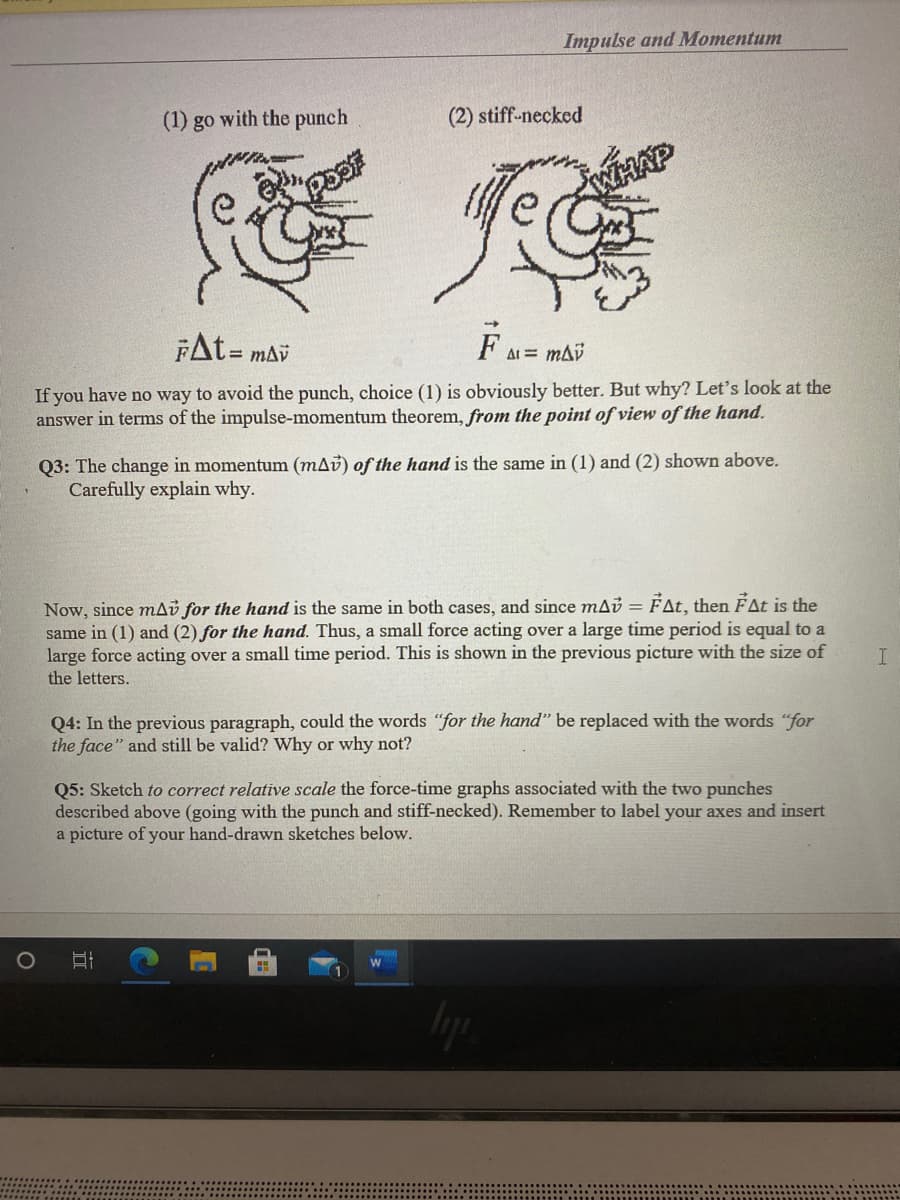If you have no way to avoid the punch, choice (1) is obviously better. But why? Let's look at the answer in terms of the impulse-momentum theorem, from the point of view of the hand. Q3: The change in momentum (mAv) of the hand is the same in (1) and (2) shown above. Carefully explain why. Now, since mAi for the hand is the same in both cases, and since mav = FAt, then FAt is the same in (1) and (2) for the hand. Thus, a small force acting over a large time period is equal to a large force acting over a small time period. This is shown in the previous picture with the size of %3D the letters
If you have no way to avoid the punch, choice (1) is obviously better. But why? Let's look at the answer in terms of the impulse-momentum theorem, from the point of view of the hand. Q3: The change in momentum (mAv) of the hand is the same in (1) and (2) shown above. Carefully explain why. Now, since mAi for the hand is the same in both cases, and since mav = FAt, then FAt is the same in (1) and (2) for the hand. Thus, a small force acting over a large time period is equal to a large force acting over a small time period. This is shown in the previous picture with the size of %3D the letters
Physics for Scientists and Engineers, Technology Update (No access codes included)
9th Edition
ISBN:9781305116399
Author:Raymond A. Serway, John W. Jewett
Publisher:Raymond A. Serway, John W. Jewett
Chapter9: Linear Momentum And Collisions
Section: Chapter Questions
Problem 9.9P: In research in cardiology and exercise physiology, it is often important to know the mass of blood...
Related questions
Question
100%
Answer all questions thank you ❤️

Transcribed Image Text:Impulse and Momentum
(1) go with the punch
(2) stiff-necked
FAt=
F A = mai
If you have no way to avoid the punch, choice (1) is obviously better. But why? Let's look at the
answer in terms of the impulse-momentum theorem, from the point of view of the hand.
Q3: The change in momentum (mAv) of the hand is the same in (1) and (2) shown above.
Carefully explain why.
Now, since mAi for the hand is the same in both cases, and since mab = FAt, then ÉAt is the
same in (1) and (2) for the hand. Thus, a small force acting over a large time period is equal to a
large force acting over a small time period. This is shown in the previous picture with the size of
the letters.
I
Q4: In the previous paragraph, could the words "for the hand" be replaced with the words "for
the face" and still be valid? Why or why not?
Q5: Sketch to correct relative scale the force-time graphs associated with the two punches
described above (going with the punch and stiff-necked). Remember to label your axes and insert
a picture of your hand-drawn sketches below.
1.
Expert Solution
This question has been solved!
Explore an expertly crafted, step-by-step solution for a thorough understanding of key concepts.
This is a popular solution!
Trending now
This is a popular solution!
Step by step
Solved in 2 steps with 2 images

Knowledge Booster
Learn more about
Need a deep-dive on the concept behind this application? Look no further. Learn more about this topic, physics and related others by exploring similar questions and additional content below.Recommended textbooks for you

Physics for Scientists and Engineers, Technology …
Physics
ISBN:
9781305116399
Author:
Raymond A. Serway, John W. Jewett
Publisher:
Cengage Learning

Principles of Physics: A Calculus-Based Text
Physics
ISBN:
9781133104261
Author:
Raymond A. Serway, John W. Jewett
Publisher:
Cengage Learning

Glencoe Physics: Principles and Problems, Student…
Physics
ISBN:
9780078807213
Author:
Paul W. Zitzewitz
Publisher:
Glencoe/McGraw-Hill

Physics for Scientists and Engineers, Technology …
Physics
ISBN:
9781305116399
Author:
Raymond A. Serway, John W. Jewett
Publisher:
Cengage Learning

Principles of Physics: A Calculus-Based Text
Physics
ISBN:
9781133104261
Author:
Raymond A. Serway, John W. Jewett
Publisher:
Cengage Learning

Glencoe Physics: Principles and Problems, Student…
Physics
ISBN:
9780078807213
Author:
Paul W. Zitzewitz
Publisher:
Glencoe/McGraw-Hill

College Physics
Physics
ISBN:
9781938168000
Author:
Paul Peter Urone, Roger Hinrichs
Publisher:
OpenStax College


University Physics Volume 1
Physics
ISBN:
9781938168277
Author:
William Moebs, Samuel J. Ling, Jeff Sanny
Publisher:
OpenStax - Rice University